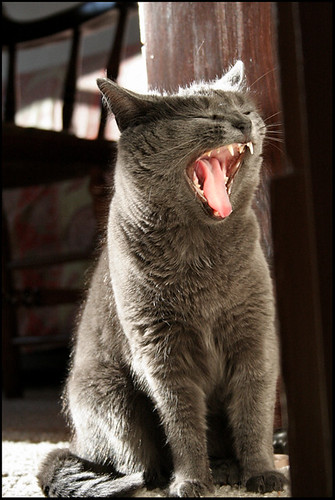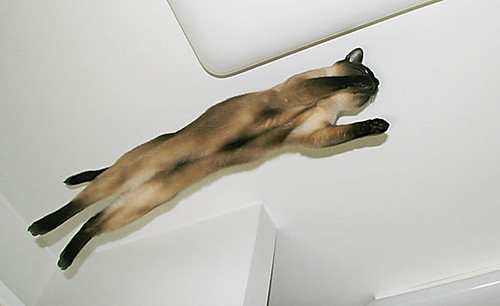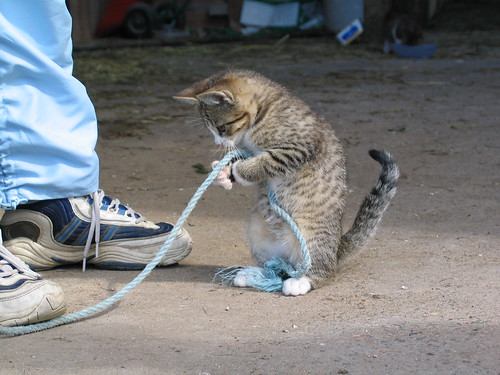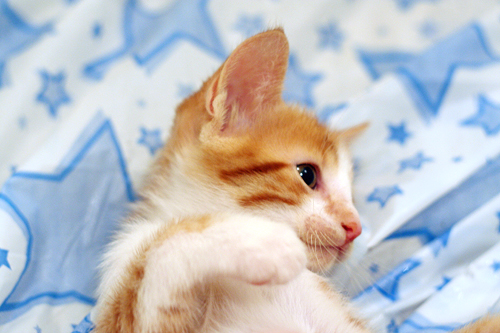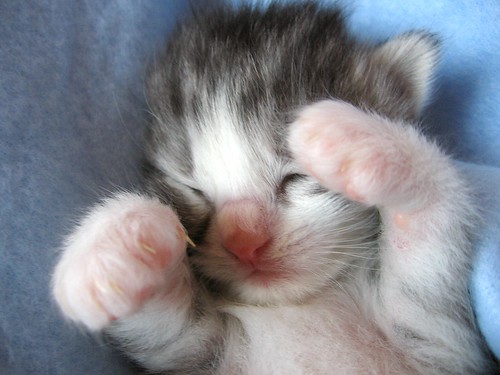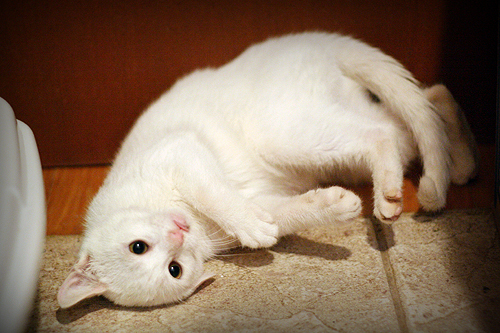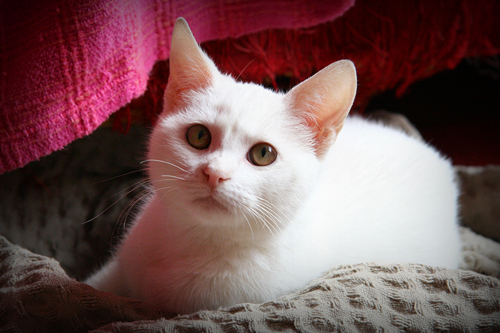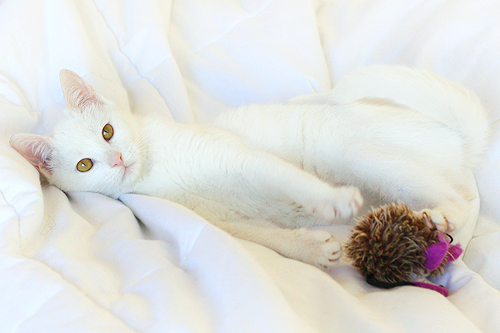I have been holding off on posting about this subject since it's had both regional and national coverage. Plus, it's somewhat of a morbid subject. However, since I grew up in this town, I have been following this story and it is just disgusting.
A story was revealed by a cyber paper called the hamdendailynews.com, which brought to light the fact that dead dogs and cats were being thrown into the town dump. Not buried, not cremated, not even hidden...just there, dumped in plain view at the local transfer station.
As the story has unfolded, it was revealed that a change in policy was made....all in the name of saving money. Apparently it was costing the town over $2,000 a year to cremate and dispose of the dead animals. Dumping them, of course, would be free. The blame game started and no one really knew who changed the policy, or when, or how. It just suddenly changed. Plus, it's still unclear where these dogs are coming from....are they dogs found on the side of the road? Or are they homeless dogs that are being euthanized after not finding a home? There is also rumor that the town doesn't go above and beyond in trying to find the owners of lost dogs. They keep the dog for the minimum amount of time (1 week), and then have them put to sleep if no owner comes forward.
I would hate to think that if my dogs ever got loose, that any town would not do the best they could to find the owner of the pet....especially that of a tax paying citizen.
After much public outcry, the policy was changed back to cremation. But, there are still plenty of letters to the editor and public war of words, since there are some people who spoke out in favor the town dog dumping, caring more about a measly $2K.
You can read the original article at http://www.hamdendailynews.com/town_gov.html#dd. There are plenty of other articles and letters to the editor -- just go back to the home page.
|
|
|---|
|
|
|---|
Friday, February 29, 2008
Wednesday, February 27, 2008
LA Pets Must Be Spayed or Neutered
A new law in LA requires all pets to be spayed or neutered before reachine four months of age.
The ordinance is aimed at reducing and eventually eliminating the thousands of euthanizations conducted in Los Angeles’ animal shelters every year.
The ordinance does exempt some animals, including those that have competed in shows or sporting competitions, guide dogs, animals used by police agencies and those belonging to professional breeders.
The average pet owner, however, must have their dog or cat spayed or neutered by the time it reaches 4 months of age (as late as 6 months with a letter from a veterinarian).
First-time offenders will receive information on subsidized sterilization services and be given an additional 60 days. If they still fail to comply they could be fined $100 and ordered to serve eight hours of community service. A subsequent offense could result in a $500 fine or 40 hours of community service.
--- My question: How does this get enforced? Is it up to the vets to enforce it? The stores? The groomers? The town when you try to register your dog? The police?
The full text of the article can be found here:
http://www.msnbc.msn.com/id/23359355/
The ordinance is aimed at reducing and eventually eliminating the thousands of euthanizations conducted in Los Angeles’ animal shelters every year.
The ordinance does exempt some animals, including those that have competed in shows or sporting competitions, guide dogs, animals used by police agencies and those belonging to professional breeders.
The average pet owner, however, must have their dog or cat spayed or neutered by the time it reaches 4 months of age (as late as 6 months with a letter from a veterinarian).
First-time offenders will receive information on subsidized sterilization services and be given an additional 60 days. If they still fail to comply they could be fined $100 and ordered to serve eight hours of community service. A subsequent offense could result in a $500 fine or 40 hours of community service.
--- My question: How does this get enforced? Is it up to the vets to enforce it? The stores? The groomers? The town when you try to register your dog? The police?
The full text of the article can be found here:
http://www.msnbc.msn.com/id/23359355/
Monday, February 25, 2008
Acclimating You New Fish
For those you enjoy the fish hobby, it's always exciting to take home that new fish. Assuming you've done your research and the fish you are adding to your tank is compatible with your current inhabitants, the next step to making sure your fish is healthy is properly acclimating the fish to the tank.
The best thing to do when you get a new fish, is to put it in a "quarantine" tank for two weeks. This is a totally separate tank with no other fish, but with the same water parameters as the main tank. However, it is often difficult for many fish keepers to have an extra quarantine tank hanging around.
Any pet store that is half-way decent will put your fish in a plastic bag. Take the bag and float it in your tank for at least 15 - 20 minutes. This will allow the water that is in the bag to become the same temperature as the tank water.
The next step is to get a bucket and a fish net. Open the bag, and pour the fish out in a net over the bucket, so that the water in the bag doesn't get into the tank. This helps prevent any impurities in the tank water from the the store from getting into your tank. Drop the fish in your tank, and watch it swim about!
The best thing to do when you get a new fish, is to put it in a "quarantine" tank for two weeks. This is a totally separate tank with no other fish, but with the same water parameters as the main tank. However, it is often difficult for many fish keepers to have an extra quarantine tank hanging around.
Any pet store that is half-way decent will put your fish in a plastic bag. Take the bag and float it in your tank for at least 15 - 20 minutes. This will allow the water that is in the bag to become the same temperature as the tank water.
The next step is to get a bucket and a fish net. Open the bag, and pour the fish out in a net over the bucket, so that the water in the bag doesn't get into the tank. This helps prevent any impurities in the tank water from the the store from getting into your tank. Drop the fish in your tank, and watch it swim about!
Sunday, February 24, 2008
Ciência
Peixe ornamental contará com programa do Governo Federal
Mais de US$ 500 milhões. Cerca de 1 bilhão de peixes de aproximadamente 4 mil espécies continentais e 1400 espécies marinhas. É o que movimenta no mundo o comércio de peixes ornamentais. Pequenas belezas dos rios e mares transformadas em animais de estimação. O Brasil, país rico em belezas naturais, é um dos mais importantes fornecedores de espécies do clima tropical, mas convive com uma série de problemas, entre eles a criminalização da atividade, a exportação irregular e a pesca predatória.
Para debater essas questões e anunciar medidas para o ordenamento e desenvolvimento da atividade no País, o ministro da pesca e da aqüicultura, Altemir Gregolin, realizou em janeiro o Encontro dos Pescadores Artesanais de Barcelos-AM – evento que integra a programação do Festival de Peixes Ornamentais - um dos mais importantes do setor. O diretor de ordenamento controle e estatística da Secretaria Especial de Aqüicultura e Pesca do Governo Federal (Seap), Mauro Rufino, também participa do evento e apresentará ações e programas do governo para a pesca e cultivo de peixes artesanais. Entre elas a melhoria da infra-estrutura de produção e a necessidade de alfabetização e capacitação dos pescadores. Ações voltadas à pesquisa com peixes ornamentais também devem ser apresentadas. O governo está formulando e pretende implementar o Programa Nacional de Apoio ao Desenvolvimento da Aqüicultura Ornamental.
Symphysodon discus
No Brasil a maior parte dos peixes ornamentais é proveniente de capturas. O Norte do Pais é pioneiro na pesca e comércio desses animais. Os primeiros registros da atividade datam de 1930. Atualmente os peixes de captura são os mais exportados, enquanto os de cultivo são mais presentes no mercado interno. No mercado interno também são mais comuns os peixes de origem continental. O comércio de peixes marinhos é considerado mais elitista, uma vez que os custos para manutenção dos aquários são maiores.
Pterophyllum scalare
É permitido pela legislação brasileira o extrativismo para fins ornamentais de 172 espécies de águas continentais e 135 marinhas. A produção de aqüicultura de peixes ornamentais no País é quase totalmente voltada para espécies de águas continentais e para o mercado interno, principalmente fornecendo para São Paulo e Rio de Janeiro.
Corydoras britskii
Tradicionalmente, as espécies de águas continentais representam um volume de comercialização superior ao de espécies marinhas. Do volume total comercializado, cerca de 90% é representado por espécimes de águas continentais e 10% por espécimes marinhos. No mundo os maiores fornecedores de peixes ornamentais são: Cingapura, República Tcheca, Estados Unidos, Hong Kong, Japão, Indonésia, Filipinas, Malásia, Israel e Marrocos. Na América do Sul, que representa em torno de 6% do total exportado mundialmente, os países mais representativos são a Colômbia, o Brasil e o Peru, que juntos exportam 96% dos peixes ornamentais desse Continente. O Brasil é o segundo maior exportador da América do Sul, e o décimo sétimo no ranking global em 2005, tendo exportado nesse ano, mais de US$ 4 milhões.
Fonte: SEAP
Pet Oral Care Product

In continuing the theme of pet dental awareness month, the Healthy Pet Company (www.healthypetcompany.com) mentioned a relatively new oral care product to the market. It's called PetzLife Oral Care and comes in sprays and gels.
According to the company, PetzLife Oral Care Spray & Gel
"are revolutionary award winning products that
thousands of satisfied customers agree not only remove
plaque and tartar but also kill bacteria on contact,
the main cause of bad breath in cats and dogs!"
The products "kill bacteria on contact" while improving kitty and dog breath. There is also a version that contains omega-3 fish oils to not only clean teeth, but help promote a healthy coat.
The convenience of the gel is that if you have dogs (like mine) who don't let you touch their teeth, you can put the gel on their lips and they'll lick it up.
Now if they could just make one like that for humans, I'd be all set :-)
Saturday, February 23, 2008
Ciência
Instituto de Pesca observa peixes para avaliar a degradação ambiental. A análise dos peixes revela impactos da ação humana.
A presença de peixes encanta os observadores, especialmente se for ampla a diversidade de cores e formas. Silenciosos, esses seres podem dizer muito - para a ciência. É o que mostra a pesquisa desenvolvida no Instituto de Pesca (IP-APTA), da Agência Paulista de Tecnologia dos Agronegócios. O estudo busca avaliar a comunidade de peixe de riachos sob os aspectos da composição e da abundância e os impactos de ações urbanas e rurais. A pesquisa também está adaptando um método para avaliar a qualidade ambiental, tendo como parâmetro a ictiofauna.
O estudo envolve a microbacia do Ribeirão Guamium, uma das oito que compõem a bacia hidrográfica do Rio Piracicaba, que abrange a região de Campinas e abastece 2,9 milhões de habitantes. O objetivo é avaliar até que ponto os diferentes usos do solo influenciam os riachos, considerando que o Guamium compreende uma região agrícola e urbana, drenando 7 mil hectares, com 17 quilômetros de extensão.
“Procuramos elaborar o método para observar se alguns parâmetros da comunidade indicam degradação ambiental”, diz a pesquisadora do IP-APTA Katharina Eichbaum Esteves. Comparando com outros riachos da região, o estudo apontou que não há perda significativa de espécies – foram identificadas 38, número similar a de outros riachos. Porém, observou-se redução de algumas espécies e proliferação de outras – desequilíbrio que afeta o ecossistema. “Às vezes há espécies predadoras que se alimentam de peixes forrageiros; ao eliminar a base da cadeia alimentar a relação entre as espécies pode ser prejudicada.”
João Paulo Feijão Teixeira, pesquisador e coordenador da APTA, ressalta o valor da pesquisa ao considerar que a biodiversidade tem valor intrínseco. “Não dá para quantificar a eliminação de espécies, há reflexos para o ecossistema como um todo”, diz Feijão.
O Guamium insere-se em uma região agrícola, nos seus trechos iniciais, e em uma região urbana, nos trechos finais, desaguando no Rio Piracicaba. Segundo Katharina Esteves, na área urbana, onde há lançamento de esgotos no riacho, detectou-se a perda de algumas espécies e a explosão populacional de outras, que passam a ser dominantes por se adaptarem às condições. “O chamado “tambiú” adapta-se bem e representa 90% da comunidade nos pontos sob influência do esgoto doméstico”, explica a pesquisadora. Outra espécie dominante é o guarú, indicando que esses grupos apresentam tolerância à poluição, podendo ser indicativas de condições de maior degradação.
O estudo, que resultou na dissertação de mestrado de Cleber Valim Alexandre no curso de Pós-Graduação em Pesca e Aqüicultura do IP-APTA, mostrou também que nos trechos de ocupação urbana há aumento de fósforo, nitrato e nitrito, indicando eutrofização, relacionada ao lançamento de esgoto. Essa condição favorece o aumento da produção de algas, grandes consumidoras de oxigênio, indicando que o meio está recebendo uma grande quantidade de nutrientes. Espécies consideradas intolerantes, como o lambari-do-rabo amarelo, ocorreram apenas nos trechos de melhor qualidade de água.
Embora o Guamium passe por grande área de produção de cana-de-açúcar, nesse estudo não foi observada alteração na comunidade de peixes causada por impacto agrícola. A preservação, nesse caso, pode estar associada à presença da vegetação ripária, que protege o entorno do riacho.
De acordo com Katharina Esteves, muitos são os benefícios da mata, que contribui para reduzir a erosão do solo, responsável pelo aumento de partículas de solo na água, que, por sua vez, aumenta a turbidez e prejudica os peixes que dependem de boa visibilidade para se comunicar ou para buscar abrigo. Ressaltam-se ainda os problemas de saúde causados aos peixes pela ausência da mata ciliar. “A ausência de árvores também pode aumentar a temperatura da água e mudar a estrutura da comunidade de peixes”, explica. A vegetação interfere ainda na cadeia alimentar, já que algumas espécies se alimentam de larvas de insetos, cujos adultos estão nas matas, e as folhas contribuem para a formação de material de fundo de rio, os detritos que são utilizados pelos peixes detritívoros.
Bioindicadores reduzem custo de avaliação da degradação
O método que utiliza bioindicadores de condição ambiental é ainda pouco usado no Brasil, mas bastante aplicado nos Estados Unidos. Dentre as vantagens da utilização de recursos bióticos como indicadores da qualidade dos ecossistemas, está o menor custo na avaliação de degradação ambiental, quando comparado, por exemplo, à análise química da água para avaliar a presença de pesticidas, herbicidas ou metais pesados.
O método considera fatores como o número total de espécies, o número de espécies de vida longa, de insetívoros, de piscívoros, de indivíduos com anomalias ou doentes, dentre outras categorias analisadas.
Financiado pela FAPESP, o estudo é feito em comparação com áreas de referência – ou seja, é preciso ter, dentro da mesma bacia hidrográfica, um rio impactado e outro naturalmente preservado. O problema é que, muitas vezes, não há rio em condições naturais em regiões industrializadas. “Por isso é importante estudar a biodiversidade dentro de áreas de conservação para se ter uma idéia de quais espécies ocorrem em condições naturais, sem influência antrópica”, diz a pesquisadora do IP-APTA, da Secretaria de Agricultura e Abastecimento.
O sistema aponta as conseqüências do problema, como a redução de espécies. “O método é de biomonitoramento, depois o estudo deve buscar as causas do problema”, diz. Esse método poderá ser adaptado para outras regiões e para a avaliação de outros organismos aquáticos, com vistas à indicação de alterações ambientais. "A tecnologia desenvolvida nessa pesquisa poderá ser aplicada em outras áreas do Estado, com a devida adaptação, e contribuir para avaliação da degradação em outras bacias hidrográficas”, afirma Feijão.
Entenda o estudo
Na prática, o trabalho consiste em coletar as espécies de peixes, agrupá-las de acordo com determinadas características biológicas, que vão desde a presença de doenças e anomalias até a tolerância às condições ambientais, verificando quais respondem melhor às alterações na qualidade do ambiente. A partir dessa adaptação, é possível propor a realização periódica de monitoramentos desses ambientes aquáticos. Viabiliza-se a identificação dos trechos mais impactados, da variação desses impactos ao longo do tempo e, conseqüentemente a ação dos agentes perturbadores no ecossistema.

O estudo envolve a microbacia do Ribeirão Guamium, uma das oito que compõem a bacia hidrográfica do Rio Piracicaba, que abrange a região de Campinas e abastece 2,9 milhões de habitantes. O objetivo é avaliar até que ponto os diferentes usos do solo influenciam os riachos, considerando que o Guamium compreende uma região agrícola e urbana, drenando 7 mil hectares, com 17 quilômetros de extensão.
“Procuramos elaborar o método para observar se alguns parâmetros da comunidade indicam degradação ambiental”, diz a pesquisadora do IP-APTA Katharina Eichbaum Esteves. Comparando com outros riachos da região, o estudo apontou que não há perda significativa de espécies – foram identificadas 38, número similar a de outros riachos. Porém, observou-se redução de algumas espécies e proliferação de outras – desequilíbrio que afeta o ecossistema. “Às vezes há espécies predadoras que se alimentam de peixes forrageiros; ao eliminar a base da cadeia alimentar a relação entre as espécies pode ser prejudicada.”
João Paulo Feijão Teixeira, pesquisador e coordenador da APTA, ressalta o valor da pesquisa ao considerar que a biodiversidade tem valor intrínseco. “Não dá para quantificar a eliminação de espécies, há reflexos para o ecossistema como um todo”, diz Feijão.
O Guamium insere-se em uma região agrícola, nos seus trechos iniciais, e em uma região urbana, nos trechos finais, desaguando no Rio Piracicaba. Segundo Katharina Esteves, na área urbana, onde há lançamento de esgotos no riacho, detectou-se a perda de algumas espécies e a explosão populacional de outras, que passam a ser dominantes por se adaptarem às condições. “O chamado “tambiú” adapta-se bem e representa 90% da comunidade nos pontos sob influência do esgoto doméstico”, explica a pesquisadora. Outra espécie dominante é o guarú, indicando que esses grupos apresentam tolerância à poluição, podendo ser indicativas de condições de maior degradação.
O estudo, que resultou na dissertação de mestrado de Cleber Valim Alexandre no curso de Pós-Graduação em Pesca e Aqüicultura do IP-APTA, mostrou também que nos trechos de ocupação urbana há aumento de fósforo, nitrato e nitrito, indicando eutrofização, relacionada ao lançamento de esgoto. Essa condição favorece o aumento da produção de algas, grandes consumidoras de oxigênio, indicando que o meio está recebendo uma grande quantidade de nutrientes. Espécies consideradas intolerantes, como o lambari-do-rabo amarelo, ocorreram apenas nos trechos de melhor qualidade de água.
Embora o Guamium passe por grande área de produção de cana-de-açúcar, nesse estudo não foi observada alteração na comunidade de peixes causada por impacto agrícola. A preservação, nesse caso, pode estar associada à presença da vegetação ripária, que protege o entorno do riacho.
De acordo com Katharina Esteves, muitos são os benefícios da mata, que contribui para reduzir a erosão do solo, responsável pelo aumento de partículas de solo na água, que, por sua vez, aumenta a turbidez e prejudica os peixes que dependem de boa visibilidade para se comunicar ou para buscar abrigo. Ressaltam-se ainda os problemas de saúde causados aos peixes pela ausência da mata ciliar. “A ausência de árvores também pode aumentar a temperatura da água e mudar a estrutura da comunidade de peixes”, explica. A vegetação interfere ainda na cadeia alimentar, já que algumas espécies se alimentam de larvas de insetos, cujos adultos estão nas matas, e as folhas contribuem para a formação de material de fundo de rio, os detritos que são utilizados pelos peixes detritívoros.
Bioindicadores reduzem custo de avaliação da degradação
O método que utiliza bioindicadores de condição ambiental é ainda pouco usado no Brasil, mas bastante aplicado nos Estados Unidos. Dentre as vantagens da utilização de recursos bióticos como indicadores da qualidade dos ecossistemas, está o menor custo na avaliação de degradação ambiental, quando comparado, por exemplo, à análise química da água para avaliar a presença de pesticidas, herbicidas ou metais pesados.
O método considera fatores como o número total de espécies, o número de espécies de vida longa, de insetívoros, de piscívoros, de indivíduos com anomalias ou doentes, dentre outras categorias analisadas.
Financiado pela FAPESP, o estudo é feito em comparação com áreas de referência – ou seja, é preciso ter, dentro da mesma bacia hidrográfica, um rio impactado e outro naturalmente preservado. O problema é que, muitas vezes, não há rio em condições naturais em regiões industrializadas. “Por isso é importante estudar a biodiversidade dentro de áreas de conservação para se ter uma idéia de quais espécies ocorrem em condições naturais, sem influência antrópica”, diz a pesquisadora do IP-APTA, da Secretaria de Agricultura e Abastecimento.
O sistema aponta as conseqüências do problema, como a redução de espécies. “O método é de biomonitoramento, depois o estudo deve buscar as causas do problema”, diz. Esse método poderá ser adaptado para outras regiões e para a avaliação de outros organismos aquáticos, com vistas à indicação de alterações ambientais. "A tecnologia desenvolvida nessa pesquisa poderá ser aplicada em outras áreas do Estado, com a devida adaptação, e contribuir para avaliação da degradação em outras bacias hidrográficas”, afirma Feijão.
Entenda o estudo
Na prática, o trabalho consiste em coletar as espécies de peixes, agrupá-las de acordo com determinadas características biológicas, que vão desde a presença de doenças e anomalias até a tolerância às condições ambientais, verificando quais respondem melhor às alterações na qualidade do ambiente. A partir dessa adaptação, é possível propor a realização periódica de monitoramentos desses ambientes aquáticos. Viabiliza-se a identificação dos trechos mais impactados, da variação desses impactos ao longo do tempo e, conseqüentemente a ação dos agentes perturbadores no ecossistema.

Friday, February 22, 2008
My dog is eating my electronics
Our dog is a good dog. He is potty trained. He rarely has any accidents. He knows how to fetch, he knows how to obay commands to sit, lay down, come, and shake.
We are also very lucky in that he hasnt been chewing on couches, furniture, shes or socks. He does have one weakness. He loves my electronics. He loves to eat blackberries, cell phones, cameras, network cables, power chargers, and sometimes even live power supplies. Here is a picture of his latest desert of my plantronics blue tooth ear piece.

We are not sure why he loves to eat electronic gadgets. We aren't sure how to train him otherwise. We provide him with bones to chew and congs so he generally leaves our stuff alone, yet he generally prefers a new shiny gadget to a hide. How do we break this habit?
We are also very lucky in that he hasnt been chewing on couches, furniture, shes or socks. He does have one weakness. He loves my electronics. He loves to eat blackberries, cell phones, cameras, network cables, power chargers, and sometimes even live power supplies. Here is a picture of his latest desert of my plantronics blue tooth ear piece.

We are not sure why he loves to eat electronic gadgets. We aren't sure how to train him otherwise. We provide him with bones to chew and congs so he generally leaves our stuff alone, yet he generally prefers a new shiny gadget to a hide. How do we break this habit?
Take the Poll!

Since February is considered dog dental health month, I'm interested in how often, if at all, dog lovers brush their dog's teeth. Take a second to click your response and feel free to leave any other comments here.
Thursday, February 21, 2008
Ciência
Cientistas australianos identificaram espécies marinhas desconhecidas no fundo do mar durante uma viagem pelas águas do leste da Antártida.
Águas-vivas com tentáculos de até seis metros, uma aranha-do-mar e fungos gigantes foram algumas das espécies que a equipe do navio Aurora Australis encontrou na viagem. A equipe coletou algumas das espécies e registrou a viagem em fotos e vídeo.
"As imagens são realmente deslumbrantes", diz Martin Riddle, que liderou a pesquisa no navio. "É impressionante navegar as montanhas e os vales do fundo do mar e ver como os animais vivem em um ambiente sem influências exteriores."
A viagem faz parte do projeto Censo da Vida Marinha Antártica, do governo australiano, que realizará 16 viagens às águas da Antártida entre 2007 e 2009.
O projeto tem o objetivo de fazer um levantamento da biodiversidade, abundância e distribuição das espécies antárticas e estabelecer um banco de dados para futuros estudos. Além disso, os cientistas irão analisar o impacto do aquecimento global nas águas da Antártida.
"As espécies coletadas durante a viagem serão enviadas para universidades e museus ao redor do mundo para identificação, e para retirar amostras dos tecidos e DNA", afirma Garaham Losie, diretor do projeto. "Certamente novas espécies serão registradas como resultado destas viagens."
Fonte e Fotos: BBC BrasilRaid Busts Up Nation's Largest Dog Fighting Rings
"TUCSON, Ariz. – A year long investigation ended Tuesday night with six people arrested and more than a 100 dogs seized in what is being called the nation’s largest dog fighting and dog-fight breeding ring.
The raid took place near Tucson, Ariz., where Pima County sheriff’s deputies served warrants and the Humane Society of the United States took custody of 150 dogs. Ninety-nine percent of the animals were pit bulls.
Authorities also found more than 50 weapons, thousands of dollars in cash, training materials and a rape stand used for breeding female pit bulls."
Here's the link to the full article.
http://www.zootoo.com/petnews/raidbustsupnationslargestdogfi\
--- I understand there is big money to be made in all forms of gambling, but I couldn't imagine making my dogs fight. In fact, my two were both cranky last night and starting fighting a bit...which is unusual for them...but made us a bit worried and upset. So, the thought of making any dogs fight just for fun is just unthinkable.
The raid took place near Tucson, Ariz., where Pima County sheriff’s deputies served warrants and the Humane Society of the United States took custody of 150 dogs. Ninety-nine percent of the animals were pit bulls.
Authorities also found more than 50 weapons, thousands of dollars in cash, training materials and a rape stand used for breeding female pit bulls."
Here's the link to the full article.
http://www.zootoo.com/petnews/raidbustsupnationslargestdogfi\
--- I understand there is big money to be made in all forms of gambling, but I couldn't imagine making my dogs fight. In fact, my two were both cranky last night and starting fighting a bit...which is unusual for them...but made us a bit worried and upset. So, the thought of making any dogs fight just for fun is just unthinkable.
Tuesday, February 19, 2008
Creating Bad Habits?
I might be guilt! I think I'm creating bad habits in my dogs. I'm an enabler. You see, when my oldest dog, Rocco, doesn't particularly like his dinner (he has allergies, so I have to be careful what I feed), he usually goes to bed hungry. Until 3am, when he wakes me up and whines.
Rocco isn't the type that usually goes to the bathroom at that hour, so I knew something else was bothering him a couple of weeks ago the first time he woke me up whining. I got up, gave him a treat, and he begged for more. Then a I realized that he didn't really eat his dinner, so he must be hungry. I got him some dry food, and he eat it up.
A few days later, the same thing happens. He doesn't eat dinner (which was a nice mix of a high quality canned food and a dry food), and then gets hungry at 3am. He wakes me, I feed him. We both go to bed happy. But, as Mrs. Pet Haven points out, now Rocco knows that he can wake me up whenever he wants and I'll feed him....not something I want to have happen every night.
So, now I must analyze what's going on here. Am I creating a bad habit? Am I basically saying that it's ok not to eat your dinner, because I'll be at your beck and call to feed you? Or am I just over-analyzing the whole thing? Obviously if he doesn't like a particular kind of food, I should try another (that he hopefully won't be allergic to!).
Has anyone else created an annoying habbit with their dogs? Would love to hear other stories. In the meantime, I have to pay extra attention to Rocco to make sure he finishes his meal and doesn't get distracted so that he'll sleep through the night.
Rocco isn't the type that usually goes to the bathroom at that hour, so I knew something else was bothering him a couple of weeks ago the first time he woke me up whining. I got up, gave him a treat, and he begged for more. Then a I realized that he didn't really eat his dinner, so he must be hungry. I got him some dry food, and he eat it up.
A few days later, the same thing happens. He doesn't eat dinner (which was a nice mix of a high quality canned food and a dry food), and then gets hungry at 3am. He wakes me, I feed him. We both go to bed happy. But, as Mrs. Pet Haven points out, now Rocco knows that he can wake me up whenever he wants and I'll feed him....not something I want to have happen every night.
So, now I must analyze what's going on here. Am I creating a bad habit? Am I basically saying that it's ok not to eat your dinner, because I'll be at your beck and call to feed you? Or am I just over-analyzing the whole thing? Obviously if he doesn't like a particular kind of food, I should try another (that he hopefully won't be allergic to!).
Has anyone else created an annoying habbit with their dogs? Would love to hear other stories. In the meantime, I have to pay extra attention to Rocco to make sure he finishes his meal and doesn't get distracted so that he'll sleep through the night.
Monday, February 18, 2008
Animal CSI: Solving horrendous pet crimes
http://www.msnbc.msn.com/id/23185183/
Interesting article on how pet crimes are being solved using the latest in crime solving technology.
Interesting article on how pet crimes are being solved using the latest in crime solving technology.
Sunday, February 17, 2008
Trib Article about Dog Transportation
The Chicago Tribune had a great article in the Transportation section about safety features in cars for dog transport. Jen Mystkowski had a great half page shot of a little dog on the cover. Unfortunatly the article is only available to online scubscribers - and i am not one of them.
Here is what i was able to get from the site and in case you have access here is the Sit. Stay. Safely. article link.
I have also broached the topic in my blog article about dog transportation here.
Here are some more interesting highlights from the article.
The article goes on to mention some pet friendly features in Subarus and Saabs. Finally here is a good reference from teh American Veterinary Medical Association. What you should know about traveling with your pet.
Here is what i was able to get from the site and in case you have access here is the Sit. Stay. Safely. article link.
Fencing, bags, safety belts, hammocks, car seats, kennels? these are just some of the items that make car-travel safe and comfortable for Fido or Fluffy.
I have also broached the topic in my blog article about dog transportation here.
Here are some more interesting highlights from the article.
29.1 million Americans say they have traveled 50 miles or more with a pet in the last three years.
The article goes on to mention some pet friendly features in Subarus and Saabs. Finally here is a good reference from teh American Veterinary Medical Association. What you should know about traveling with your pet.
Saturday, February 16, 2008
Behind The Scenes at Dog Show
Thanks to Petside for sharing this clip..some behind the scenes grooming at the Westminster Dog show.
Friday, February 15, 2008
Pet Travel by Air
Traveling by Air
Air travel is often the most convenient way to get to your destination, but if you plan to take Fluffy on board, you need to be aware of the extra procedures and dangers headed your way.
Here are some tips sent to me by Travel Hacker. Their site can be found at
http://www.airlinecreditcards.com/travelhacker/how-to-travel-with-pets-the-ultimate-guide/
Tips for Safe Pet Air Travel: Visit the Human Society’s website for tips on keeping your pet comfortable and safe during a planet trip.
Stow your pet under the seat in front of you: If your dog or cat is small enough to comfortably fit in a carrier the size of most carry-on items, you may be able to keep your pet under the seat in front of you for the entire plane trip. That way, your furry friend won’t be subjected to riding alone in the back with everyone’s heavy suitcases.
Put identification information everywhere: First, make sure your pet’s ID tags are securely attached to his or her collar. Go ahead and clip another ID tag or luggage tag onto the carrier door, and consider writing your contact information directly on the animal’s carrier to avoid mistakes and theft.
Research companies that specialize in transporting pets: Companies like Pet Air specialize in transporting pets, taking care of everything from booking flights to selling kennels and carriers.
TakeYourPet.com Travel Tips: This guide from TakeYourPet.com suggests trimming your animal’s nails to minimize the injury it can cause to itself, you and other animals or people.
Pack a toy or favorite comfort item in your pet’s carrier: To make the trip more comfortable for your pet, pack a familiar toy or blanket inside your pet’s carrier to ease their anxiety. Rawhides aren’t always a good idea, though, as they can cause upset stomachs.
Bring a photo of your pet: In case you have trouble finding your pet after landing, have a recent photo ready to show airport security and baggage claim attendants to prove you’re the owner and help locate your pet.
Pack pet meds in accordance with TSA carry-on regulations: Make sure you pack your pet’s medications in a TSA-approved system, which requires that liquids and gels 3 oz. or less be packed in a quart-sized plastic zip-top bag. If you have to dump out your pet’s medicine or take a later flight to have time to stick it in your check bags, you could be in for a disaster.
Pack a small bowl for water: Dogs and cats can get dehydrated easily, so bring a small bowl or collapsible container so that your pet has water as soon as you land or retrieve it from the baggage claim.
Be familiar with airline travel restrictions and guidelines: Before booking a flight for your pet, make sure you are prepared to deal with all travel restrictions set forth by the airline. Many airlines like Delta require pets to be at least 8 weeks old, restrict the destinations where pets can fly to, and charge a fee for in-cabin carriers.
Pet Air Travel: Ask-the-Vet.com publishes this guide to taking pets on an airplane, including a list of pet regulations for several major airlines.
Air travel is often the most convenient way to get to your destination, but if you plan to take Fluffy on board, you need to be aware of the extra procedures and dangers headed your way.
Here are some tips sent to me by Travel Hacker. Their site can be found at
http://www.airlinecreditcards.com/travelhacker/how-to-travel-with-pets-the-ultimate-guide/
Tips for Safe Pet Air Travel: Visit the Human Society’s website for tips on keeping your pet comfortable and safe during a planet trip.
Stow your pet under the seat in front of you: If your dog or cat is small enough to comfortably fit in a carrier the size of most carry-on items, you may be able to keep your pet under the seat in front of you for the entire plane trip. That way, your furry friend won’t be subjected to riding alone in the back with everyone’s heavy suitcases.
Put identification information everywhere: First, make sure your pet’s ID tags are securely attached to his or her collar. Go ahead and clip another ID tag or luggage tag onto the carrier door, and consider writing your contact information directly on the animal’s carrier to avoid mistakes and theft.
Research companies that specialize in transporting pets: Companies like Pet Air specialize in transporting pets, taking care of everything from booking flights to selling kennels and carriers.
TakeYourPet.com Travel Tips: This guide from TakeYourPet.com suggests trimming your animal’s nails to minimize the injury it can cause to itself, you and other animals or people.
Pack a toy or favorite comfort item in your pet’s carrier: To make the trip more comfortable for your pet, pack a familiar toy or blanket inside your pet’s carrier to ease their anxiety. Rawhides aren’t always a good idea, though, as they can cause upset stomachs.
Bring a photo of your pet: In case you have trouble finding your pet after landing, have a recent photo ready to show airport security and baggage claim attendants to prove you’re the owner and help locate your pet.
Pack pet meds in accordance with TSA carry-on regulations: Make sure you pack your pet’s medications in a TSA-approved system, which requires that liquids and gels 3 oz. or less be packed in a quart-sized plastic zip-top bag. If you have to dump out your pet’s medicine or take a later flight to have time to stick it in your check bags, you could be in for a disaster.
Pack a small bowl for water: Dogs and cats can get dehydrated easily, so bring a small bowl or collapsible container so that your pet has water as soon as you land or retrieve it from the baggage claim.
Be familiar with airline travel restrictions and guidelines: Before booking a flight for your pet, make sure you are prepared to deal with all travel restrictions set forth by the airline. Many airlines like Delta require pets to be at least 8 weeks old, restrict the destinations where pets can fly to, and charge a fee for in-cabin carriers.
Pet Air Travel: Ask-the-Vet.com publishes this guide to taking pets on an airplane, including a list of pet regulations for several major airlines.
Thursday, February 14, 2008
Ciência
A construção de uma barragem prejudica o ciclo reprodutivo de diversas espécies de peixes ao impedir que eles nadem rio acima em busca de um local apropriado para a desova. Para minimizar o problema, a solução mais comum é a construção de escadas – seqüências de tanques que formam uma corredeira artificial capaz de estimular a subida dos cardumes.
No entanto, um novo estudo feito por pesquisadores da Universidade Estadual de Maringá, no Paraná, mostra que as escadas para peixes, idealizadas originalmente para salmões na América do Norte, são uma armadilha mortal para as espécies tropicais. O dispositivo aumentaria o risco de extinção das populações que vivem rio abaixo das barragens. O trabalho, de Fernando Pelicice e Angelo Agostinho, foi publicado na edição de fevereiro da revista Conservation Biology e foi objeto de reportagem na revista Nature.
De acordo com Agostinho, o estudo comprovou que as escadas para peixes preenchem todos os requisitos para serem enquadradas no conceito de armadilha ecológica. Idealizadas como medida de conservação, elas atuam como uma fonte adicional de impacto ambiental.
Prochilodus lineatus
“Confirmamos que as escadas apresentam diversos problemas. O principal deles é que, depois de subir, os peixes adultos e as larvas não voltam mais e, assim, não completam o ciclo reprodutivo. Eles acabam confinados no trecho acima do reservatório, onde o ambiente é mais pobre para a reprodução”, disse à *Agência FAPESP*.
O estudo é resultado de uma série de pesquisas em parceria com a Universidade de Tocantins. Foram observadas as escadas dos reservatórios de Porto Primavera, no rio Paraná, do complexo do rio Paranapanema e da usina de Lajeado, no rio Tocantins.
“Reunimos um grande volume de dados que incluíam levantamentos sobre as escadas, reprodução de peixes, larvas e estudos genéticos. Utilizamos esse conhecimento para aplicar o conceito de armadilhas ecológicas”, disse Agostinho.
Em seu ciclo de vida natural, peixes como o Dourado (Salminus brasiliensis), Pintado (Pseudoplatystoma corruscans), Piracanjuba (Brycon orbignyanus), Pacu (Piaractus mesopotamicus) e Curimbatá (Prochilodus lineatus) migram rio acima durante a época de cheia para desovar em tributários.
Mas a volta é fundamental para o ciclo reprodutivo. “Os ovos descem pelo turbilhão das águas enquanto se desenvolvem e, ao chegar na região de várzea, adentram canais e lagoas. Nesses ambientes marginais, desconectados dos rios fora da época de cheia, eles encontram ambiente seguro para crescer. Na cheia seguinte, voltam aos rios e se integram aos cardumes de adultos”, explica Agostinho.
Bom para salmão!
Segundo Angelo Agostinho, as espécies migradoras são afeitas às águas rápidas. Depois de utilizar as escadas para passar ao segmento superior do rio, os peixes não voltam mais, pois são desestimulados ao encontrar as águas paradas do reservatório.
“É efetivamente uma armadilha. O peixe sai do trecho abaixo da barragem, onde poderia completar seu ciclo, e vai para o trecho acima, onde não tem condições de retornar”, destacou.
Na parte de baixo, segundo Agostinho, os peixes e larvas poderiam encontrar águas turvas e meandros apropriados para se abrigar dos predadores. “Na parte de cima ele pode até encontrar tributários do rio onde pode desovar, mas as larvas descem para o reservatório e encontram uma água parada e límpida, onde dificilmente escapam de predadores.”
Piaractus mesopotamicus
De acordo com Pelicice, que é o autor principal do estudo, as escadas foram concebidas para salmonídeos que, vindos do mar, sobem os rios, atravessam as escadas e reservatórios e desovam nas cabeceiras. As escadas funcionam no hemisfério Norte porque os salmões adultos não precisam voltar: eles desovam apenas uma vez na vida e o ciclo se completa numa só jornada. Os peixes da América do Sul, no entanto, desovam diversas vezes na vida.
“No caso dos salmões, a migração descendente ocorre quando o peixe já tem 12 a 15 centímetros . Por isso, quando migra rio abaixo, o peixe jovem tem condições de passar pelo reservatório e pelos vertedouros. Entre nossos grandes migradores, são as ovas que descem passivamente, por 70 ou 80 quilômetros , enquanto se desenvolvem. Quando encontram o reservatório, ficam à deriva e podem ser predadas por qualquer lambari”, disse Agostinho.
Os peixes da América do Sul, segundo Pelicice, deslocam-se ao longo do rio, dispersando-se pela bacia. Se não têm chance de voltar do barramento, o estoque diminui, ao longo do tempo, na juzante (na parte de baixo do rio).
Sem estímulo para retornar
De acordo com Agostinho, as escadas deveriam ser fechadas quando não há locais para os peixes completarem seu ciclo na montante da barragem. “A escada de Lajeado foi fechada, por solicitação do Ibama, exatamente porque se notou que havia prejuízo para a reprodução das espécies. Mas aquela área, ao contrário do caso de Canoas, não caracteriza uma armadilha, pois conta com vastas áreas acima da barragem”, afirmou o professor titular do Núcleo de Pesquisas em Limnologia, Ictiologia e Apicultura.
Pseudoplatystoma corruscans
Pelicice ressalta que o dispositivo da escada, em si, não representa dificuldade para que os peixes desçam o rio de volta. “O problema é o reservatório. Quando terminam de subir, eles atravessam a água estagnada em busca do trecho superior de rio. Mas, quando tentam voltar, são desestimulados pelo reservatório e nem alcançam a escada de volta”, explicou.
Segundo Agostinho além de impedir a volta dos peixes adultos e larvas, as escadas não servem para a maioria das espécies. “Elas são implantadas sem um objetivo claro, simplesmente porque há um senso comum que acredita em sua utilidade. Mas só algumas poucas espécies acabam utilizando as escadas, nem sempre as migradoras. Do ponto de vista da conservação, as escadas são ineficazes”, disse.
Exemplo de Barragem
Fotos: SBI, Practical Fish Keeping,...
Fonte: Agência FAPESP
Happy Valentine's Day
Hope everyone enjoy's their day. I always hated this holiday, since it was another way to make me spend money on stuff I don't need. But, now that I have a mini family, I can understand the point of it....still, I'm not spending any money! No flowers for Mrs. Pet Haven until next week, when the price for roses goes back down to a normal level. And no exotic dinners until next week, when the restaurants go back to their 'regular' menus, rather then the ones with the prices jacked up for tonight. I know, this sounds a bit crass, but she would kill me if I overspent on flowers and food.
The dogs enjoy the holiday as well; and they don't care how much I spend either, as long as they get their doggie treats. But I'm extra careful not to drop any of the chocolates that are in my house. If it's near their noses, they'll find it and eat it!
As for the fish, they're getting their regular weekly water changes. So, they'll be happy.
And, for us baseball fans, it's the official start of spring training, as pitchers and catchers report to camp.
I'm starting to like Feb. 14th afterall!!
The dogs enjoy the holiday as well; and they don't care how much I spend either, as long as they get their doggie treats. But I'm extra careful not to drop any of the chocolates that are in my house. If it's near their noses, they'll find it and eat it!
As for the fish, they're getting their regular weekly water changes. So, they'll be happy.
And, for us baseball fans, it's the official start of spring training, as pitchers and catchers report to camp.
I'm starting to like Feb. 14th afterall!!
Wednesday, February 13, 2008
Tuesday, February 12, 2008
Westminster Dog Show - Shih Tzu and Bichon Frise
I can not believe that I have found myself watching the Westminster Dog show. I suppose our little shichon has made a big impact on us. Although a shichon is not a recognized breed by the westmister dog kenel, the Shichon / Zuchon parents are.
Here are the videos for the BICHONS FRISES show.
And the show vides for Shih Tzu.
Unfortunately the Westminster Kennel club doesnt allow me to embed the video here. Luckily i found a fan who posted the intro on YouTube:
And here is some news - the Westminster Dog Show website doesnt have this up yet - the 2008 Westminster Kennel Club 2008 Best In Show was won by a 15 inch Beagle!

Here are the videos for the BICHONS FRISES show.
And the show vides for Shih Tzu.
Unfortunately the Westminster Kennel club doesnt allow me to embed the video here. Luckily i found a fan who posted the intro on YouTube:
And here is some news - the Westminster Dog Show website doesnt have this up yet - the 2008 Westminster Kennel Club 2008 Best In Show was won by a 15 inch Beagle!

11 Ch K-Run's Park Me In First
Breed: Beagle, 15 In.
Sex: Dog
AKC: HP 16966001
Date of Birth: May 05, 2005
Breeder: Kathy Weichert & Leah Bertagnolli
Sire: Ch Windkist A Walk In The Park
Dam: Ch Legacy's Lil Secret At K-Run
Owner: Caroline Dowell & Eddie Dziuk & Jon Woodring & Kathy Weichert
Photos: Breed judging / Group judging
Rent a Dog?
I saw a report on ABC News about a company that rents out dogs. You can go there, rent a dog for a day, and then bring it back and move on. It's available at FlexPet in San Diego, LA, and New York. After paying a $150 initiation fee and monthly dues, people who are approved by the place can then rent a dog for a fee of $40 a day...but here's the best part, a person interviewed representing the company said that they don't consider it a rental....they like to think of it more like a time share!
Animal rights activists aren't pleased...and as one person said in the story, it's kind of like doggie prostitution. I couldn't agree more. Dogs are companion animals and need a consistent companion. In somes ways, this is like torture to the dogs, not being able to bond to any one peson.
Think of how confused the dogs are? They really don't have a home to go to. They just live at a doggie day-care type of place with a bunch of other dogs and are taken out by renters. Every day, a different person is taking them home, treating them differently then the person the day before, and then bringing back to the rental place.
If animals are considered property under the law, then in this situation, the dogs are treated like it. If you want to view the piece, here is the link. http://abcnews.go.com/Video/playerIndex?id=4280842
I'm interested to hear everyone's opinion.
Animal rights activists aren't pleased...and as one person said in the story, it's kind of like doggie prostitution. I couldn't agree more. Dogs are companion animals and need a consistent companion. In somes ways, this is like torture to the dogs, not being able to bond to any one peson.
Think of how confused the dogs are? They really don't have a home to go to. They just live at a doggie day-care type of place with a bunch of other dogs and are taken out by renters. Every day, a different person is taking them home, treating them differently then the person the day before, and then bringing back to the rental place.
If animals are considered property under the law, then in this situation, the dogs are treated like it. If you want to view the piece, here is the link. http://abcnews.go.com/Video/playerIndex?id=4280842
I'm interested to hear everyone's opinion.
Caring

My young cute sis
Monday, February 11, 2008
U.S. Attorney Indicts U.S. and Chinese Companies in Pet Food Scandal
According to a report by Pet Product News International, three companies are facing federal charges in relation to the distribution of a contaminated pet food ingredient that might have cost more than 4,000 dogs and cats their lives.
Recently, a federal grand jury indicted a U.S. food importer and two Chinese firms for their roles in manufacturing and distributing contaminated wheat gluten that sickened thousands of pets. ChemNutra of Las Vegas and its executives, husband and wife team Steve and Sally Miller, are facing 27 charges, including 13 misdemeanor charges alleging they "delivered adulterated food, which contained melamine," 13 misdemeanor charges alleging they "introduced misbranded foods into interstate commerce," and a felony wire fraud conspiracy charge alleging that the Millers and ChemNutra participated in a conspiracy to defraud the companies that purchased some of the Chinese-firm manufactured wheat gluten by "concealing material facts from those purchasers."
The full story can be found: http://www.petproductnews.com/headlines/us-attorney-indicts-us-and-chinese-companies-in-pet-food-scandal.aspx
Personally, I think the more that is done to help prevent this crisis from happening again, the better. The fact that they are accused of concealing material facts from purchasers tells you right there the intent.
Recently, a federal grand jury indicted a U.S. food importer and two Chinese firms for their roles in manufacturing and distributing contaminated wheat gluten that sickened thousands of pets. ChemNutra of Las Vegas and its executives, husband and wife team Steve and Sally Miller, are facing 27 charges, including 13 misdemeanor charges alleging they "delivered adulterated food, which contained melamine," 13 misdemeanor charges alleging they "introduced misbranded foods into interstate commerce," and a felony wire fraud conspiracy charge alleging that the Millers and ChemNutra participated in a conspiracy to defraud the companies that purchased some of the Chinese-firm manufactured wheat gluten by "concealing material facts from those purchasers."
The full story can be found: http://www.petproductnews.com/headlines/us-attorney-indicts-us-and-chinese-companies-in-pet-food-scandal.aspx
Personally, I think the more that is done to help prevent this crisis from happening again, the better. The fact that they are accused of concealing material facts from purchasers tells you right there the intent.
Sunday, February 10, 2008
My New Friend

Me and my young chick friend wandering around at my landlord backyard
Saturday, February 9, 2008
Laughing Cat

Ha ha ha ha ha.... What so funny..??!!!
Friday, February 8, 2008
Pet Shop Lemon Law
I saw this on News Channel 8 in Connecticut. It's an interesting discussion (and a sad story) based on the "Pet shop lemon law." Basically, you can only get your money back within 15 days of purchase. And most stores will only give you money back if give them the dog. And of course, we can guess what will happen to that poor puppy in most cases.
For those interested, check out the text of the stories:
http://www.wtnh.com/Global/story.asp?S=7841431
http://www.wtnh.com/Global/story.asp?S=7845433
My thoughts on this are wide ranging, as I can understand both sides of the arguement. I'm very familiar with this particular store, and their dogs are very well-treated, clean, and come with their first vaccines. However, the store doesn't make a point to x-ray each dog to search for all the minute problems. I don't think we could really expect any store, or even every shelter, to go that far.
Hopefully the community can come together to help the people and dogs who are mentioned in this story.
For those interested, check out the text of the stories:
http://www.wtnh.com/Global/story.asp?S=7841431
http://www.wtnh.com/Global/story.asp?S=7845433
My thoughts on this are wide ranging, as I can understand both sides of the arguement. I'm very familiar with this particular store, and their dogs are very well-treated, clean, and come with their first vaccines. However, the store doesn't make a point to x-ray each dog to search for all the minute problems. I don't think we could really expect any store, or even every shelter, to go that far.
Hopefully the community can come together to help the people and dogs who are mentioned in this story.
Ciência
Cientista cria peixe transparente para ser 'laboratório vivo'
O peixe é uma variedade do popular paulistinha, também conhecido como peixe-zebra – um peixe ornamental de água doce muito comum em lojas de aquarismo do Brasil e que normalmente tem faixas pretas horizontais no corpo.
O peixe foi criado pelo doutor Richard White, do Hospital Infantil de Boston, que disse que a análise do paulistinha transparente pode permitir um melhor acompanhamento de doenças e processos biológicos de evolução rápida.
Segundo White, em estudos sobre o câncer, por exemplo, o método convencional de dissecar um animal com o mal não é satisfatório. "É como tirar uma foto quando você precisa de um vídeo", afirmou.
Experimentos
O próprio pesquisador "testou" o paulistinha transparente, realizando primeiramente um experimento em que analisou a forma como células de um tumor na pele (melanoma) se comportaram depois de terem sido criadas, com um pigmento fluorescente, dentro do abdômen do animal.
Em um período de cinco dias, as células, vistas ao microscópio, pareceram se alastrar da cavidade abdominal para a pele do peixe, onde se sentiriam "em casa".
"Isso nos diz que, quando células de um tumor se espalham para outras partes do corpo, não o fazem de forma aleatória", disse White. "Elas sabem para onde ir."
O pesquisador afirma que os cientistas ainda não sabem ao certo o que leva um tumor cancerígeno localizado a se espalhar para outras partes do corpo, tornando-se posteriormente fatais.
No estudo com o paulistinha, White disse ter sido capaz de ver exatamente como o câncer começou a se espalhar e mesmo como cada célula cancerígena individualmente se multiplicou – em tempo real, em um ser vivo.
Célula-tronco
Em outro experimento que fez, o cientista analisou com detalhes como células-tronco que levam à produção de células de sangue reagiram ao serem transplantadas no paulistinha.
Novamente, o cientista elogiou o uso do peixe transparente, que permitiu até mesmo a observação de células-tronco individuais.
"O que acontece em um organismo vivo é diferente do que o que acontece em uma placa de petri (instrumento cilíndrico de laboratório usado em culturas de células e microrganismos em geral)", disse.
Para criar o novo peixe, o pesquisador simplesmente cruzou duas variedades já existentes de paulistinha, que geraram uma terceira sem pigmentos no corpo.
O paulistinha de White não é o único peixe transparente. Há algumas espécies que naturalmente têm poucos ou nenhum pigmento no corpo, como é o caso do peixe-vidro (Chanda ranga).
Fonte: BBC Brasil
Prêmios
Minha grande amiga Renatinha me presenteou várias vezes no dia de hoje. Assim vou ficar mal acostumado, o Nature Planet esta bombando de prêmios!!!!




Assim como ela, repassarei os quatro prêmio de uma só vez...
Vamos la:
Aquarium Fotografia Blog



Assim como ela, repassarei os quatro prêmio de uma só vez...
Vamos la:
Aqua hobbie
Akuatic
Ikebanana
Biologia Virtual
FAAO
Xylema
By Osc@r Luiz
renatinha no blogger
Obrigado e que todos apreciem!
Abraços
Thursday, February 7, 2008
Why Dogs Burrow
Does your dog like to burrow under the covers? There is actually an explanation of why according to an MSN.com article in their dog central section.
Dogs are denning animals, they love small spaces. In the same way that humans like to fluff up their pillows before settling in for the night, some dogs like to create comfy beds and hide under clothes and sheets to make themselves feel safe, warm and comfortable. All breeds may do this, but terriers, hounds and huskies are more predisposed to burrowing than others.
There’s no downside or risk to letting your dog burrow, unless you don’t want dog hair under the covers. A separate dog bed might be handy to keep the hair out of yours. An additional bonus of your dog having the instinct to burrow is that it can make crate training easier, since being in a crate can mimic that denlike environment.
So the next the time your dog wants to get under your covers, just know that she's just trying to find a safe place to sleep.
Dogs are denning animals, they love small spaces. In the same way that humans like to fluff up their pillows before settling in for the night, some dogs like to create comfy beds and hide under clothes and sheets to make themselves feel safe, warm and comfortable. All breeds may do this, but terriers, hounds and huskies are more predisposed to burrowing than others.
There’s no downside or risk to letting your dog burrow, unless you don’t want dog hair under the covers. A separate dog bed might be handy to keep the hair out of yours. An additional bonus of your dog having the instinct to burrow is that it can make crate training easier, since being in a crate can mimic that denlike environment.
So the next the time your dog wants to get under your covers, just know that she's just trying to find a safe place to sleep.
Wednesday, February 6, 2008
Breeder - Hybrid Mixed Puppies
I have received several comments asking about the breeder of Monkey, our shichon (zuchon) puppy whose father and mother were a Bichon and a ShiTzu.
Take a look at this earlier post which gives the info and website of the breeder.
Good luck and I hope you find a wonderful Hybrid mixed puppy and give it a great home!
Take a look at this earlier post which gives the info and website of the breeder.
Good luck and I hope you find a wonderful Hybrid mixed puppy and give it a great home!
Labels:
breeder,
chicago dog breeder,
illinois breeder,
mixed puppies
Tuesday, February 5, 2008
Canine Obesity Check
February is National Canine Weight Check (NCWC) month, according to a site called StopCanineObesity.com.
Here are some facts as provided by the site:
In the meantime, here's more info on NCWC:
The National Canine Weight Check is an effort to raise awareness about the health complications that may be faced by overweight dogs and help owners determine if their dogs are at risk.
Throughout the month of February, we're encouraging owners to get a free weight check for their dogs at a participating vet's office. To find a local vet, visit http://www.stopcanineobesity.com/findavet.
The event is supported by the American Kennel Club Humane Fund and by thousands of veterinarians across the country, through a sponsorship by Pfizer Animal Health.
You can find out more information about the program at http://www.stopcanineobesity.com/ncwc .
We've also provided you with the BARC (Body Assessment Rating for Canines) quiz, an easy tool to help identify if your dog is a prime candidate for a weight check, http://stopcanineobesity.com/barc.htm.
Here are some facts as provided by the site:
In the meantime, here's more info on NCWC:
The National Canine Weight Check is an effort to raise awareness about the health complications that may be faced by overweight dogs and help owners determine if their dogs are at risk.
Throughout the month of February, we're encouraging owners to get a free weight check for their dogs at a participating vet's office. To find a local vet, visit http://www.stopcanineobesity.com/findavet.
The event is supported by the American Kennel Club Humane Fund and by thousands of veterinarians across the country, through a sponsorship by Pfizer Animal Health.
You can find out more information about the program at http://www.stopcanineobesity.com/ncwc .
We've also provided you with the BARC (Body Assessment Rating for Canines) quiz, an easy tool to help identify if your dog is a prime candidate for a weight check, http://stopcanineobesity.com/barc.htm.
Monday, February 4, 2008
Misleading Pet Sales Tactic
I always advocate doing your homework before making any major purchase; and a pet is a major purchase. The beauty of the internet is that you can search for anything you need. Not all the info will be totally accurate, but if you read enough stuff, you'll find that many sites will basically tell you the same things...and the ones that don't are probably the ones that aren't accurate.
With this being said, I was somewhat surprised with a sign posted at a pet store I visited over the weekend. In their attempts to "upsell" everything, there was a sign that said "buy a tank today, take home a fish today." Basically saying that if you're buying the tank, you might as well buy the fish too.
Now, for those that are doing their research before purchasing, they would know that a new tank set-up takes time. You should never put a fish in a new tank until the water is in, the filter is running, and the decorations are settled. Plus, the water should circulate for at least a few days before adding any fish. This allows for the colonies of the so-called 'good' bacteria to grow. I won't go into the complexities of why this needs to occur (though it's covered in many of my other posts), but it does bother me that this sign was posted.
As consumers, we look to our local pet stores, especially the ones that aren't big chains, to provide us with knowledge about our potential purchases. We expect them to be honest and do what it best for the pets, before doing what is best for their bottom lines. There is an expectation of responsibility when you're buying live animals, and this sign was far beyond irresponsible.
Hopefully, no one fell for the trap and overspent on a fish that most likely died if they took it home the same day the tank was set up.
With this being said, I was somewhat surprised with a sign posted at a pet store I visited over the weekend. In their attempts to "upsell" everything, there was a sign that said "buy a tank today, take home a fish today." Basically saying that if you're buying the tank, you might as well buy the fish too.
Now, for those that are doing their research before purchasing, they would know that a new tank set-up takes time. You should never put a fish in a new tank until the water is in, the filter is running, and the decorations are settled. Plus, the water should circulate for at least a few days before adding any fish. This allows for the colonies of the so-called 'good' bacteria to grow. I won't go into the complexities of why this needs to occur (though it's covered in many of my other posts), but it does bother me that this sign was posted.
As consumers, we look to our local pet stores, especially the ones that aren't big chains, to provide us with knowledge about our potential purchases. We expect them to be honest and do what it best for the pets, before doing what is best for their bottom lines. There is an expectation of responsibility when you're buying live animals, and this sign was far beyond irresponsible.
Hopefully, no one fell for the trap and overspent on a fish that most likely died if they took it home the same day the tank was set up.
Sunday, February 3, 2008
Happy Super Bowl Sunday!
I know, it's not really a national holiday, but maybe it should be! It's the big game, with parties, celebrations, and of course, what we've all been waiting for...the new commercials.
Don't forget to keep your pets safe. The basic tips apply here too, such as making sure the pets aren't getting too scared or getting harassed by your guests. Don't feed them anything you wouldn't normally give them and make sure they aren't close to anything you don't want knocked over.
Enjoy the game. Here's hoping that some day, Congress will make the day after the Super Bowl a national holiday.
Don't forget to keep your pets safe. The basic tips apply here too, such as making sure the pets aren't getting too scared or getting harassed by your guests. Don't feed them anything you wouldn't normally give them and make sure they aren't close to anything you don't want knocked over.
Enjoy the game. Here's hoping that some day, Congress will make the day after the Super Bowl a national holiday.
Saturday, February 2, 2008
Grooming Disaster - part 1
Our poor little shichon puppy had to get all of his fur cut off! Yes, it is middle of January, and despite my pleading and strictly against my suggestions, my wife took him to the groomers and had him completely shaved.
See for yourself:
Monkey before grooming (see the curly Bichon like coat which kept him warm)

Now after the grooming:

Granted he actually looks like he has legs, but he is COLD! Especially since it dropped to 10 degrees Fahrenheit in Chicago a week after all his fur was gone. Just see how comfortable hi is in this video of him (with his fur) frolicking around in the snow.
Now there were reasons for this. Apparently Shichons (and I suppose other small dogs like the Bichons and Shitzus) need special grooming brushes etc, and his fur was 'rasta' like matted. But more on this in Grooming lessons part 2.
See for yourself:
Monkey before grooming (see the curly Bichon like coat which kept him warm)
Now after the grooming:
Granted he actually looks like he has legs, but he is COLD! Especially since it dropped to 10 degrees Fahrenheit in Chicago a week after all his fur was gone. Just see how comfortable hi is in this video of him (with his fur) frolicking around in the snow.
Now there were reasons for this. Apparently Shichons (and I suppose other small dogs like the Bichons and Shitzus) need special grooming brushes etc, and his fur was 'rasta' like matted. But more on this in Grooming lessons part 2.
Salmonella from pet turtles sickens 103 in '07
Ok, so I've wanted a turtle for some time now. But Mrs. Pet Haven always cautioned me that you could get diseases from turtles. I never really knew if she was making that up, but as it turns out, she's right. According to a recent report, contact with small pet turtles was to blame for 103 Salmonella infections that occurred in 33 states between May and December 2007, according to federal health officials from the Centers for Disease Control and Prevention, Atlanta.
Salmonella infections can be severe, leading to hospitalization and, in some cases, death, the CDC notes.
Turtles and other reptiles are well-known reservoirs for Salmonella and while the sale and distribution of small turtles — measuring less than 4 inches — was officially outlawed in the U.S. in 1975, cases of turtle-associated Salmonella infection continue to occur.
Roughly half of the Salmonella infections documented in the 2007 outbreak occurred in young children, who are at greater risk for severe illness from Salmonella infection.
The CDC's investigation into the outbreak also revealed that in a subset of 60 infected individuals interviewed, only one fifth were aware of the link between Salmonella infection and contact with reptiles.
According to the CDC, direct or indirect contact with reptiles causes an estimated 6 percent of all human Salmonella infections in the U.S. People who come in contact with reptiles, reptile habitats, or surfaces contaminated with reptile feces need to remember that they risk Salmonella infection, CDC officials caution.
Salmonella infections can be severe, leading to hospitalization and, in some cases, death, the CDC notes.
Turtles and other reptiles are well-known reservoirs for Salmonella and while the sale and distribution of small turtles — measuring less than 4 inches — was officially outlawed in the U.S. in 1975, cases of turtle-associated Salmonella infection continue to occur.
Roughly half of the Salmonella infections documented in the 2007 outbreak occurred in young children, who are at greater risk for severe illness from Salmonella infection.
The CDC's investigation into the outbreak also revealed that in a subset of 60 infected individuals interviewed, only one fifth were aware of the link between Salmonella infection and contact with reptiles.
According to the CDC, direct or indirect contact with reptiles causes an estimated 6 percent of all human Salmonella infections in the U.S. People who come in contact with reptiles, reptile habitats, or surfaces contaminated with reptile feces need to remember that they risk Salmonella infection, CDC officials caution.
Subscribe to:
Comments (Atom)
|
|
|---|





























